Abstract
Mild hyperhomocysteinemia is an established risk factor for cardiovascular disease. Genetic aberrations in the cystathionine beta-synthase (CBS) and methylenetetrahydrofolate reductase (MTHFR) genes may account for reduced enzyme activities and elevated plasma homocysteine levels. In 15 unrelated Dutch patients with homozygous CBS deficiency, we observed the 833T-->C (I278T) mutation in 50% of the alleles. Very recently, we identified a common mutation (677C-->T; A-->V) in the MTHFR gene, which, in homozygous state, is responsible for the thermolabile phenotype and which is associated with decreased specific MTHRF activity and elevated homocysteine levels. We screened 60 cardiovascular patients and 111 controls for these two mutations, to determine whether these mutations are risk factors for premature cardiovascular disease. Heterozygosity for the 833T-->C mutation in the CBS gene was observed in one individual of the control group but was absent in patients with premature cardiovascular disease. Homozygosity for the 677C-->T mutation in the MTHFR gene was found in (15%) of 60 cardiovascular patients and in only 6 (approximately 5%) of 111 control individuals (odds ratio 3.1 [95% confidence interval 1.0-9.2]). Because of both the high prevalence of the 833T-->C mutation among homozygotes for CBS deficiency and its absence in 60 cardiovascular patients, we may conclude that heterozygosity for CBS deficiency does not appear to be involved in premature cardiovascular disease. However, a frequent homozygous mutation in the MTHFR gene is associated with a threefold increase in risk for premature cardiovascular disease.
Full text
PDF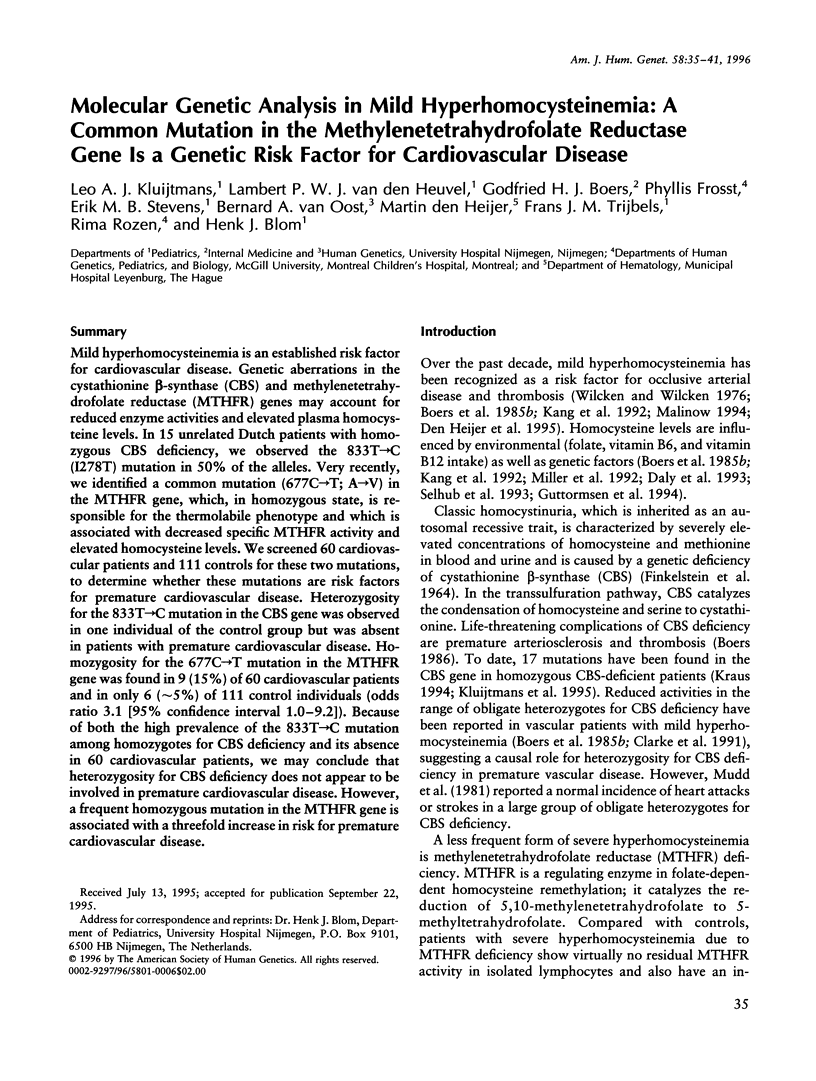
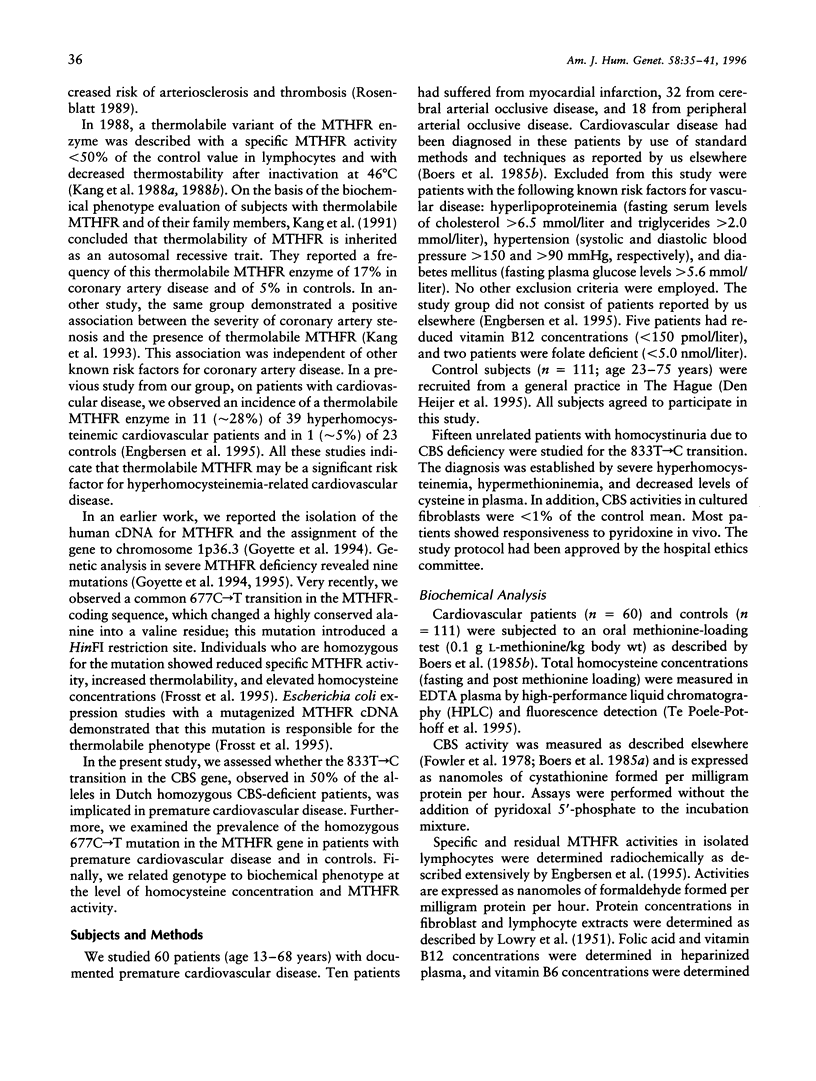
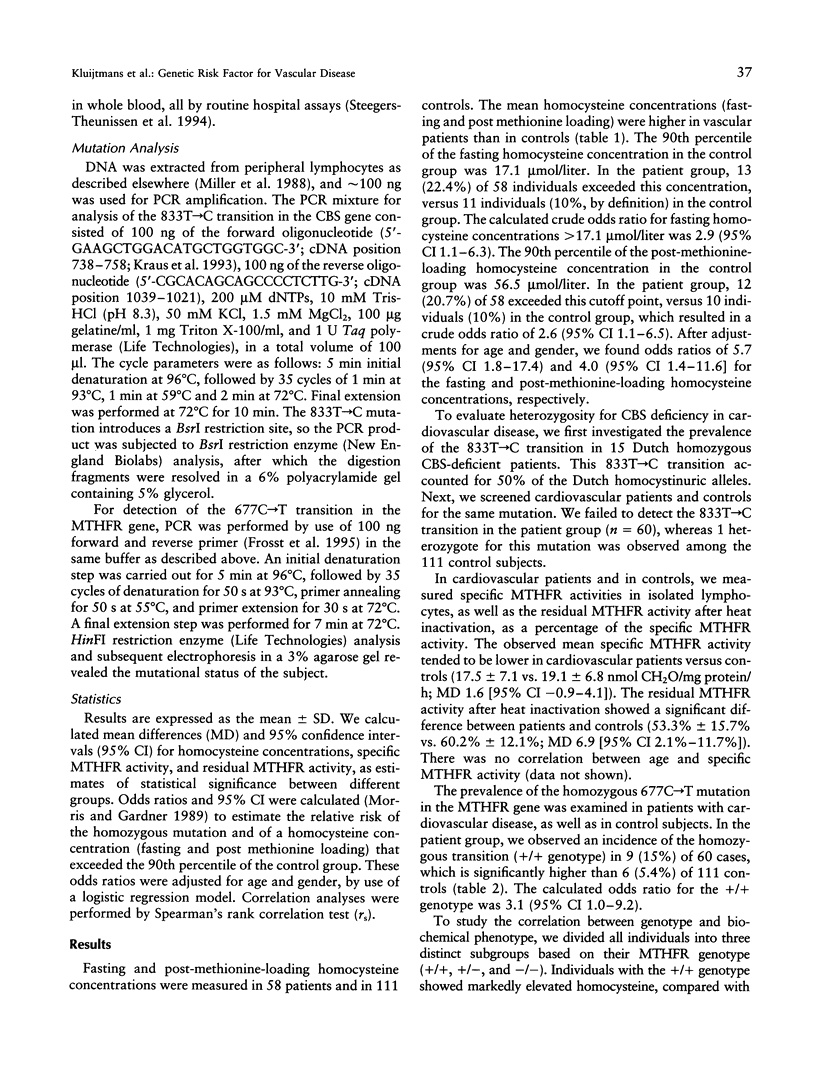


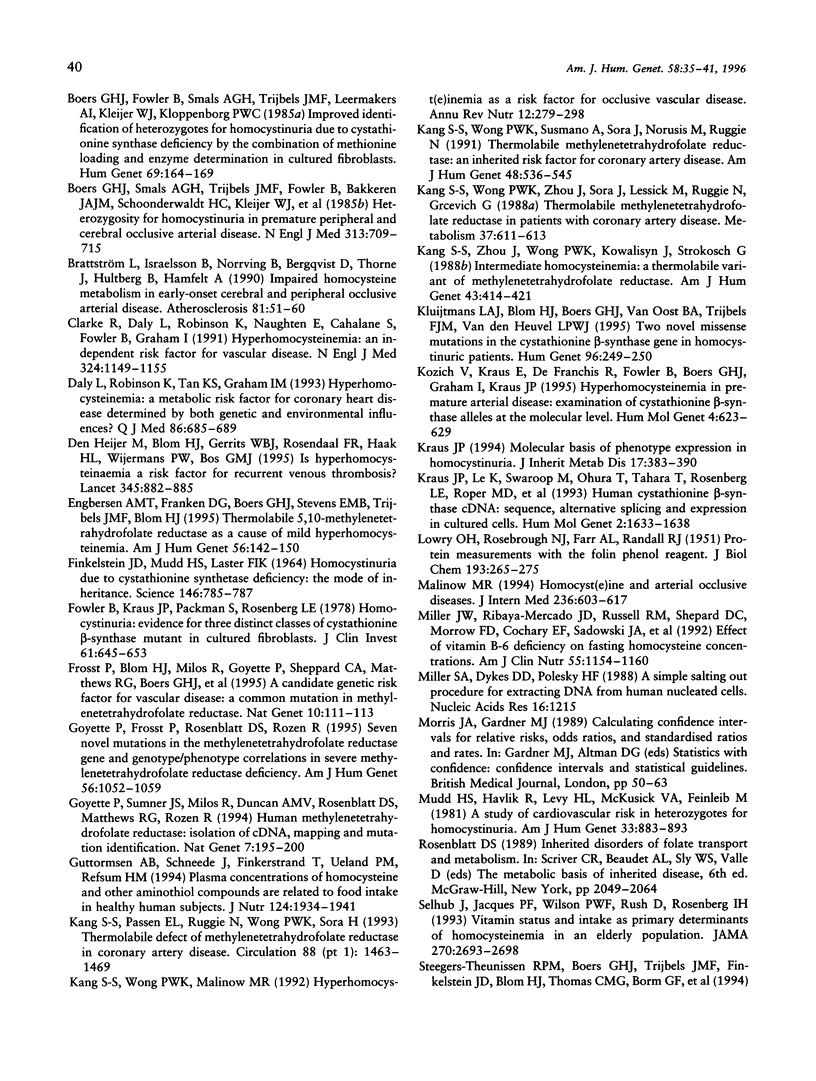
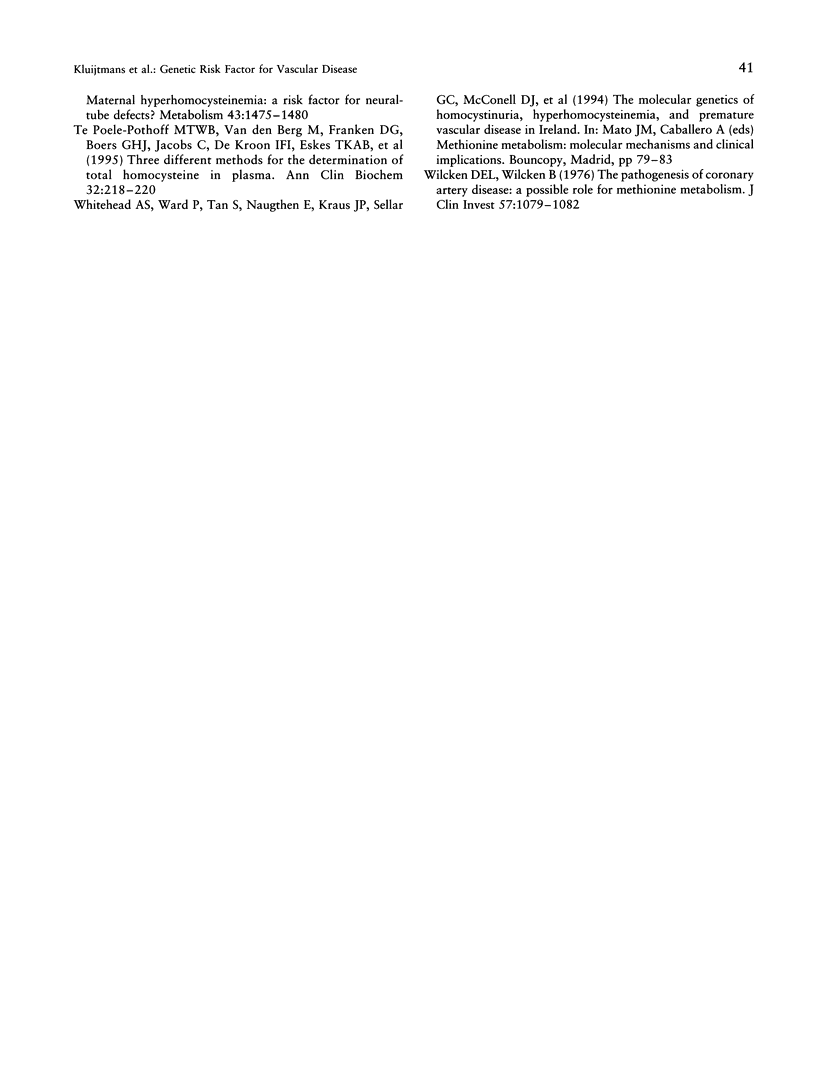
Selected References
These references are in PubMed. This may not be the complete list of references from this article.
- Boers G. H., Fowler B., Smals A. G., Trijbels F. J., Leermakers A. I., Kleijer W. J., Kloppenborg P. W. Improved identification of heterozygotes for homocystinuria due to cystathionine synthase deficiency by the combination of methionine loading and enzyme determination in cultured fibroblasts. Hum Genet. 1985;69(2):164–169. doi: 10.1007/BF00293290. [DOI] [PubMed] [Google Scholar]
- Boers G. H., Smals A. G., Trijbels F. J., Fowler B., Bakkeren J. A., Schoonderwaldt H. C., Kleijer W. J., Kloppenborg P. W. Heterozygosity for homocystinuria in premature peripheral and cerebral occlusive arterial disease. N Engl J Med. 1985 Sep 19;313(12):709–715. doi: 10.1056/NEJM198509193131201. [DOI] [PubMed] [Google Scholar]
- Brattström L., Israelsson B., Norrving B., Bergqvist D., Thörne J., Hultberg B., Hamfelt A. Impaired homocysteine metabolism in early-onset cerebral and peripheral occlusive arterial disease. Effects of pyridoxine and folic acid treatment. Atherosclerosis. 1990 Feb;81(1):51–60. doi: 10.1016/0021-9150(90)90058-q. [DOI] [PubMed] [Google Scholar]
- Clarke R., Daly L., Robinson K., Naughten E., Cahalane S., Fowler B., Graham I. Hyperhomocysteinemia: an independent risk factor for vascular disease. N Engl J Med. 1991 Apr 25;324(17):1149–1155. doi: 10.1056/NEJM199104253241701. [DOI] [PubMed] [Google Scholar]
- Daly L., Robinson K., Tan K. S., Graham I. M. Hyperhomocysteinaemia: a metabolic risk factor for coronary heart disease determined by both genetic and environmental influences? Q J Med. 1993 Oct;86(10):685–689. doi: 10.1093/qjmed/86.10.685. [DOI] [PubMed] [Google Scholar]
- Engbersen A. M., Franken D. G., Boers G. H., Stevens E. M., Trijbels F. J., Blom H. J. Thermolabile 5,10-methylenetetrahydrofolate reductase as a cause of mild hyperhomocysteinemia. Am J Hum Genet. 1995 Jan;56(1):142–150. [PMC free article] [PubMed] [Google Scholar]
- FINKELSTEIN J. D., MUDD S. H., IRREVERRE F., LASTER L. HOMOCYSTINURIA DUE TO CYSTATHIONINE SYNTHETASE DEFICIENCY: THE MODE OF INHERITANCE. Science. 1964 Nov 6;146(3645):785–787. doi: 10.1126/science.146.3645.785. [DOI] [PubMed] [Google Scholar]
- Fowler B., Kraus J., Packman S., Rosenberg L. E. Homocystinuria. Evidence for three distinct classes of cystathionine beta-synthase mutants in cultured fibroblasts. J Clin Invest. 1978 Mar;61(3):645–653. doi: 10.1172/JCI108976. [DOI] [PMC free article] [PubMed] [Google Scholar]
- Frosst P., Blom H. J., Milos R., Goyette P., Sheppard C. A., Matthews R. G., Boers G. J., den Heijer M., Kluijtmans L. A., van den Heuvel L. P. A candidate genetic risk factor for vascular disease: a common mutation in methylenetetrahydrofolate reductase. Nat Genet. 1995 May;10(1):111–113. doi: 10.1038/ng0595-111. [DOI] [PubMed] [Google Scholar]
- Goyette P., Frosst P., Rosenblatt D. S., Rozen R. Seven novel mutations in the methylenetetrahydrofolate reductase gene and genotype/phenotype correlations in severe methylenetetrahydrofolate reductase deficiency. Am J Hum Genet. 1995 May;56(5):1052–1059. [PMC free article] [PubMed] [Google Scholar]
- Goyette P., Sumner J. S., Milos R., Duncan A. M., Rosenblatt D. S., Matthews R. G., Rozen R. Human methylenetetrahydrofolate reductase: isolation of cDNA, mapping and mutation identification. Nat Genet. 1994 Jun;7(2):195–200. doi: 10.1038/ng0694-195. [DOI] [PubMed] [Google Scholar]
- Guttormsen A. B., Schneede J., Fiskerstrand T., Ueland P. M., Refsum H. M. Plasma concentrations of homocysteine and other aminothiol compounds are related to food intake in healthy human subjects. J Nutr. 1994 Oct;124(10):1934–1941. doi: 10.1093/jn/124.10.1934. [DOI] [PubMed] [Google Scholar]
- Kang S. S., Passen E. L., Ruggie N., Wong P. W., Sora H. Thermolabile defect of methylenetetrahydrofolate reductase in coronary artery disease. Circulation. 1993 Oct;88(4 Pt 1):1463–1469. doi: 10.1161/01.cir.88.4.1463. [DOI] [PubMed] [Google Scholar]
- Kang S. S., Wong P. W., Malinow M. R. Hyperhomocyst(e)inemia as a risk factor for occlusive vascular disease. Annu Rev Nutr. 1992;12:279–298. doi: 10.1146/annurev.nu.12.070192.001431. [DOI] [PubMed] [Google Scholar]
- Kang S. S., Wong P. W., Susmano A., Sora J., Norusis M., Ruggie N. Thermolabile methylenetetrahydrofolate reductase: an inherited risk factor for coronary artery disease. Am J Hum Genet. 1991 Mar;48(3):536–545. [PMC free article] [PubMed] [Google Scholar]
- Kang S. S., Wong P. W., Zhou J. M., Sora J., Lessick M., Ruggie N., Grcevich G. Thermolabile methylenetetrahydrofolate reductase in patients with coronary artery disease. Metabolism. 1988 Jul;37(7):611–613. doi: 10.1016/0026-0495(88)90076-5. [DOI] [PubMed] [Google Scholar]
- Kang S. S., Zhou J., Wong P. W., Kowalisyn J., Strokosch G. Intermediate homocysteinemia: a thermolabile variant of methylenetetrahydrofolate reductase. Am J Hum Genet. 1988 Oct;43(4):414–421. [PMC free article] [PubMed] [Google Scholar]
- Kluijtmans L. A., Blom H. J., Boers G. H., van Oost B. A., Trijbels F. J., van den Heuvel L. P. Two novel missense mutations in the cystathionine beta-synthase gene in homocystinuric patients. Hum Genet. 1995 Aug;96(2):249–250. doi: 10.1007/BF00207394. [DOI] [PubMed] [Google Scholar]
- Kozich V., Kraus E., de Franchis R., Fowler B., Boers G. H., Graham I., Kraus J. P. Hyperhomocysteinemia in premature arterial disease: examination of cystathionine beta-synthase alleles at the molecular level. Hum Mol Genet. 1995 Apr;4(4):623–629. doi: 10.1093/hmg/4.4.623. [DOI] [PubMed] [Google Scholar]
- Kraus J. P. Komrower Lecture. Molecular basis of phenotype expression in homocystinuria. J Inherit Metab Dis. 1994;17(4):383–390. doi: 10.1007/BF00711354. [DOI] [PubMed] [Google Scholar]
- Kraus J. P., Le K., Swaroop M., Ohura T., Tahara T., Rosenberg L. E., Roper M. D., Kozich V. Human cystathionine beta-synthase cDNA: sequence, alternative splicing and expression in cultured cells. Hum Mol Genet. 1993 Oct;2(10):1633–1638. doi: 10.1093/hmg/2.10.1633. [DOI] [PubMed] [Google Scholar]
- LOWRY O. H., ROSEBROUGH N. J., FARR A. L., RANDALL R. J. Protein measurement with the Folin phenol reagent. J Biol Chem. 1951 Nov;193(1):265–275. [PubMed] [Google Scholar]
- Malinow M. R. Homocyst(e)ine and arterial occlusive diseases. J Intern Med. 1994 Dec;236(6):603–617. doi: 10.1111/j.1365-2796.1994.tb00854.x. [DOI] [PubMed] [Google Scholar]
- Miller J. W., Ribaya-Mercado J. D., Russell R. M., Shepard D. C., Morrow F. D., Cochary E. F., Sadowski J. A., Gershoff S. N., Selhub J. Effect of vitamin B-6 deficiency on fasting plasma homocysteine concentrations. Am J Clin Nutr. 1992 Jun;55(6):1154–1160. doi: 10.1093/ajcn/55.6.1154. [DOI] [PubMed] [Google Scholar]
- Miller S. A., Dykes D. D., Polesky H. F. A simple salting out procedure for extracting DNA from human nucleated cells. Nucleic Acids Res. 1988 Feb 11;16(3):1215–1215. doi: 10.1093/nar/16.3.1215. [DOI] [PMC free article] [PubMed] [Google Scholar]
- Mudd S. H., Havlik R., Levy H. L., McKusick V. A., Feinleib M. A study of cardiovascular risk in heterozygotes for homocystinuria. Am J Hum Genet. 1981 Nov;33(6):883–893. [PMC free article] [PubMed] [Google Scholar]
- Selhub J., Jacques P. F., Wilson P. W., Rush D., Rosenberg I. H. Vitamin status and intake as primary determinants of homocysteinemia in an elderly population. JAMA. 1993 Dec 8;270(22):2693–2698. doi: 10.1001/jama.1993.03510220049033. [DOI] [PubMed] [Google Scholar]
- Steegers-Theunissen R. P., Boers G. H., Trijbels F. J., Finkelstein J. D., Blom H. J., Thomas C. M., Borm G. F., Wouters M. G., Eskes T. K. Maternal hyperhomocysteinemia: a risk factor for neural-tube defects? Metabolism. 1994 Dec;43(12):1475–1480. doi: 10.1016/0026-0495(94)90004-3. [DOI] [PubMed] [Google Scholar]
- Wilcken D. E., Wilcken B. The pathogenesis of coronary artery disease. A possible role for methionine metabolism. J Clin Invest. 1976 Apr;57(4):1079–1082. doi: 10.1172/JCI108350. [DOI] [PMC free article] [PubMed] [Google Scholar]
- den Heijer M., Blom H. J., Gerrits W. B., Rosendaal F. R., Haak H. L., Wijermans P. W., Bos G. M. Is hyperhomocysteinaemia a risk factor for recurrent venous thrombosis? Lancet. 1995 Apr 8;345(8954):882–885. doi: 10.1016/s0140-6736(95)90008-x. [DOI] [PubMed] [Google Scholar]
- te Poele-Pothoff M. T., van den Berg M., Franken D. G., Boers G. H., Jakobs C., de Kroon I. F., Eskes T. K., Trijbels J. M., Blom H. J. Three different methods for the determination of total homocysteine in plasma. Ann Clin Biochem. 1995 Mar;32(Pt 2):218–220. doi: 10.1177/000456329503200218. [DOI] [PubMed] [Google Scholar]


